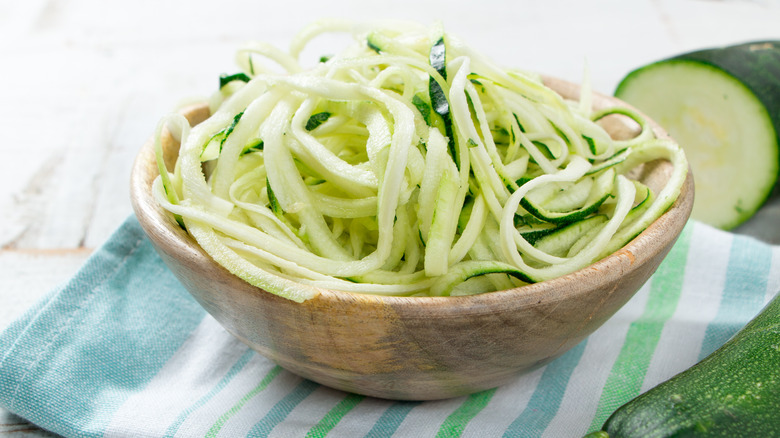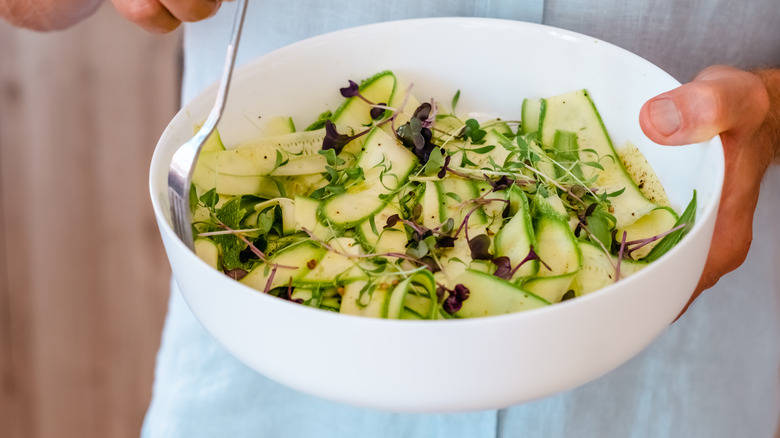Don't Have A Spiralizer? Use A Julienne Peeler For Zucchini Noodles Instead
Whether you're trying to add more veggies to your diet or you're craving something lighter than regular noodles, zucchini noodles are a great alternative to pasta. In a world where there's a kitchen gadget for seemingly everything, you can certainly find plenty of spiralizers on the market — but you don't necessarily need one to make zucchini noodles. If you have a julienne peeler you'll have no problem turning your zucchini into thin, noodle-like shapes that can serve as the base for a variety of dishes like zucchini noodles with fresh tomato sauce or coconut lime shrimp with zoodles.
Unlike other types of vegetable peelers, a julienne peeler has serrated teeth rather than just a straight edge for cutting, so it produces long, thin ribbons when used on fruits and vegetables. When using it to make zucchini noodles, simply drag the julienne peeler down the length of your zucchini, and you'll end up with straight, thin ribbons that resemble angel hair or spaghetti. Julienne peelers are more affordable options than spiralizers, and they're also smaller and more multi-purpose, making them a great investment if you don't already have one in your kitchen.
Tips for using a julienne peeler to make zucchini noodles
It's important to start with fresh, raw zucchini, so look for squash with firm, bright green skin that's smooth to the touch and doesn't have wrinkles or discoloration. The skin is edible and nutritious, so there's no need to peel the skin before getting to work, although you do need to wash and dry it. When using a julienne peeler, ensure that it's sharp. These types of peelers dull over time, so if you've been using the same peeler frequently for more than a year, you might want to consider replacing it if you plan to make a lot of zucchini noodles.
You'll also want to turn the zucchini periodically to make sure the noodles are even and to avoid the seeds in the middle of the squash. Apply even pressure as you peel to help keep the strands the same width and length. Zucchini can be slippery, and it's easy for a julienne peeler to get away from you and cut your hand, so be careful! To prevent any dangerous mishaps, place the zucchini on a sturdy cutting board, drag the peeler away from your hands, and don't go too fast. You can consider investing in cut-resistant gloves if you want an added layer of protection.
Other ways to make zucchini noodles
You'll want to consider how you plan to use your zucchini noodles before deciding how to make them, as the julienne peeler method won't work for all recipes. If you need a more pappardelle-like shape instead of a spaghetti-like shape, try using a traditional, non-serrated vegetable peeler to make flatter, broader noodles. A mandolin slicer, grater, or even just a knife (and some patience) will also work, so don't let not having a spiralizer stop you. Believe it or not, there's even a soda can hack that can serve as a makeshift spiralizer in a pinch, too.
No matter what tool you use, the problem with zoodles is that — due to the high water content in zucchini — they often turn out soggy. To combat this, after you make your zucchini noodles, salt them and allow them to sit for 10 to 15 minutes between a layer of paper towels to draw out the moisture. Unlike with traditional noodles, boiling is not a requirement. You can make tasty dishes like zucchini pasta with almond pesto by simply sautéing the zucchini noodles in a skillet.


